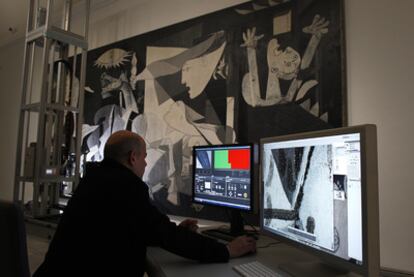Getting deeper into 'Guernica'
A detailed robot study is set to assess the condition of Picasso's masterpiece
The room of the Reina Sofía Museum that holds Picasso's famous anti-war mural Guernica looks like a movie set. It would not be a complete surprise to see Steven Spielberg walk in and start supervising the movements of the automated, nine-meter-long by 3.5-meter-high camera that has been purpose-built to analyze the state of the most emblematic artwork of the 20th century.
Funded by Telefónica, this robotic device, mounted on a dolly, moves in front of the painting with a precision of 25 micrometers. Sensors and cameras take millions of super-high-resolution shots that will reveal new, detailed information about Guernica thanks to infrared, ultraviolet and 3D scanning technology.
The robot moves in front of the painting with a precision of 25 micrometers
To avoid any inconvenience for museum visitors, the robot will only work during closing hours, at night and on Tuesday and Sunday afternoons. During the day, everyone will be able to admire a work of art that spent most of its life in exile, much of it at New York's MoMA, before returning to Spain in 1981.
Jorge García Gómez-Tejedor, head of the Reina Sofía's restoration department, explains that this new machine will produce the most comprehensive study to date on the state of Guernica's preservation. When the robot's work is done, the results will allow experts to know more about the state of the various layers of paint, the surface, and even unknown aspects about its development and the materials and techniques used on the mural.
Reina Sofía director Manuel Borja-Villel notes that the last X-ray study carried out on Guernica was in 1998. The results were debated by a panel of experts who made it clear the artwork was in a very delicate state of health and that it could not be moved from where it was.
"Since then, techniques have evolved significantly," he adds. "New plates and studies have been made, but the robot will be the one who lets us know about the exact state of the painting and what to do with it."
But Borja-Villel is clear about one thing: that Guernica will not leave his museum, despite repeated statements by the head of the Prado Museum, Miguel Zugaza, expressing his wish to see the mural displayed there again (it was at the Prado until 1992, when Spain's 20th-century art collection moved to the new Reina Sofía facilities).
"There is nothing to be done about it," says Borja-Villel. "The trustees decided it this way. This piece is essential to the museum. It cannot be separated from the context of the 1930s. Our great summer exhibition, which we will present in June, focuses on Guernica and the Spanish Pavilion at the 1937 World Expo."
After all, the museum director jokes, there are some items from the Hermitage Museum in St Petersburg on show at the Prado that he has his eye on ? but he is not going to ask Vladimir Putin for them.
When the robot is done with its work on the mural, it will be used on other museum pieces requiring attention. This revolutionary and costly piece of equipment (Francisco Serrano, Telefónica's cultural chief, declined to give any figures) will become one of the museum's restoration tools.
"The Telefónica company was created just 13 years before Picasso painted Guernica," he says. "Our technology could not remain indifferent to the needs of the painting."

Tu suscripción se está usando en otro dispositivo
¿Quieres añadir otro usuario a tu suscripción?
Si continúas leyendo en este dispositivo, no se podrá leer en el otro.
FlechaTu suscripción se está usando en otro dispositivo y solo puedes acceder a EL PAÍS desde un dispositivo a la vez.
Si quieres compartir tu cuenta, cambia tu suscripción a la modalidad Premium, así podrás añadir otro usuario. Cada uno accederá con su propia cuenta de email, lo que os permitirá personalizar vuestra experiencia en EL PAÍS.
¿Tienes una suscripción de empresa? Accede aquí para contratar más cuentas.
En el caso de no saber quién está usando tu cuenta, te recomendamos cambiar tu contraseña aquí.
Si decides continuar compartiendo tu cuenta, este mensaje se mostrará en tu dispositivo y en el de la otra persona que está usando tu cuenta de forma indefinida, afectando a tu experiencia de lectura. Puedes consultar aquí los términos y condiciones de la suscripción digital.
Últimas noticias
From Andorra to Gibraltar, a black market for Ozempic exploits its success: ‘They’re the most sought-after products in the world’
From Hungary’s Orbán to Chile’s Kast: How Trump helps turbo charge the far right
Magnets in their heads: How some animals guide themselves using the Earth’s magnetic field
The brief rise and retreat of Generation Z in Mexico
Most viewed
- Why we lost the habit of sleeping in two segments and how that changed our sense of time
- Trump’s obsession with putting his name on everything is unprecedented in the United States
- Charles Dubouloz, mountaineering star, retires at 36 with a farewell tour inspired by Walter Bonatti
- Venezuela faces its most tense Christmas yet
- The Florida Keys tourist paradise is besieged by immigration agents: ‘We’ve never seen anything like this’








































